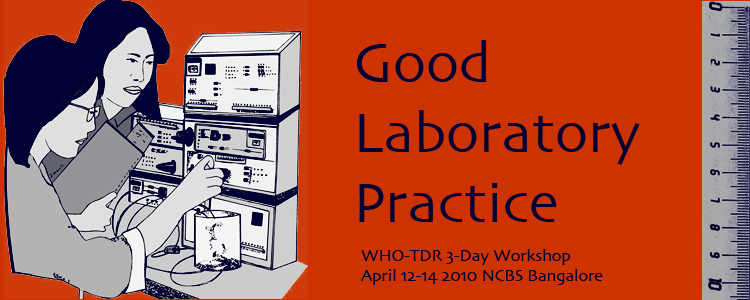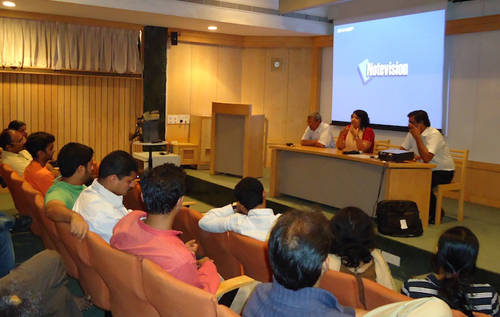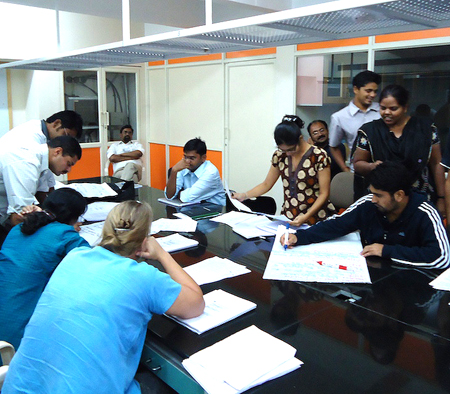Good Laboratory Practice
Science seems to attract a naturally cautious breed. When you actually start doing research, however, you soon realise that an entirely new level of cautiousness is called for. The perils of "confirmation bias", Murphy’s Law, and the sheer technological complexity of even a routine experiment can quickly humble the researcher and drive home the value of taking every aspect of a project very, very seriously. Nature does not yield her secrets easily.
Scientists learn the many aspects of "taking things seriously" largely by trial and error, or via the informal advice of their colleagues. Last week however thirty NCBS researchers had the benefit of a more systematic approach to education in this area: a 3-day workshop that provided an introduction to a consolidated body of knowledge called Good Laboratory Practice (GLP).
The history of GLP
GLP first evolved in the USA in the 1970s in response to investigations by the US Food and Drug Administration (FDA) into the practices of US toxicology laboratories. They found the system deeply flawed. Although these labs were providing data to regulatory bodies on vital issues of public safety, they were not using standardised methods, their experiments were poorly planned, and there were few if any attempts at quality control. It was clear that the research process in this sector was itself in need of regulation. The FDA and later the US Environmental Protection Agency assumed responsibility for writing the regulations that had to be followed by all US toxicology labs. A further advance occurred in 1981 when the Organization for Economic Cooperation and Development (OECD) published a set of GLP Principles. These guidelines are a more accessible version of the legally-oriented regulations. All member states of the OECD have signed up to the GLP Principles, as have many non-OECD countries.
The widespread acceptance of GLP Principles encouraged the Tropical Diseases Research unit (TDR) of the World Health Organisation (WHO) to organise a network of GLP trainers to spread the word in disease-endemic countries. Three Indian members of this network: Dr Deepak Agarwal, Indian Institute of Toxicology, Lucknow; Dr Sudhir Srivastava, Former Head of Toxicology, Central Drug Research Institute, Lucknow; and Dr Geetha Rajashekar, Consultant, Qualtox Consultancy, Bangalore, came to NCBS last week to share their great knowledge of GLP with staff and students.
GLP comes to NCBS
The workshop was an intense and useful experience for the participants, with the theory (presented in six lectures) reinforced by 18 hours of group practical exercises. Lectures and practical exercises were based on the GLP Trainee handbook, available online for free. The two components of GLP that seem to have had the most impact were those that come under the categories of "Rules" and "Results". Rules include "protocols" and "standard operating procedures" (SOPs). Protocols are more general, and describe the experimental design and time-frame. For devising a well-thought-out protocol, participants reported favourably on the usefulness of a specialised form of mind-mapping (the Ishikawa, or Fishbone, Diagram) that is much used in the field of quality control. SOPs are used for capturing greater technical detail than the protocol (e.g. for a generic method to isolate DNA). In any given experiment, all deviations from the SOP need to be carefully documented in the lab notebook. SOPs facilitate standardisation, and thus repeatability and reliability, of procedures. In addition they make it easier for incoming lab members to quickly get up to speed, and, from an occupational health and safety point of view, they serve as a convenient focus for thinking about how to minimise risk. Protocols and SOPs do mean more upfront work, but the participants were convinced of the benefits. As Tejas Gupte, course participant, says: "I found the sections on designing the study plan (especially the Fishbone method) very useful, and early stage PhD students may be introduced to such methods to help them design and plan their projects and thus accelerate their research."
The "Results" component also struck a chord with many participants. Guidelines were given for the collection of raw data; maintenance of lab notebooks; the publication of results; and the archiving of all the aforementioned "results". GLP encourages a very conscientious and systematic approach that basically fine-tunes the typical academic process. One important shift in perspective is that, with respect to data collection, the GLP system gives equal weight to the multitude of associated conditions that can affect an experiment. When were the instruments calibrated? What was the batch lot of the treatment drug? What was the exact timeline used when making measurements? The GLP system encourages researchers to try to predict as many of these factors in advance and to incorporate questions about them in a proforma that will be routinely used when recording data. More work, but it is effort that may pay big dividends. As course participant Sony Malhotra saw it: "We have gathered the knowledge of how to plan the work in a more structured and easy manner, and this means we don’t waste time later thinking about the why, how and when we did something."
How applicable is GLP to an academic environment?
The GLP regulations were originally developed for labs doing routine toxicological assessments, based on standardised equipment and well-established test procedures. In such labs responsibilities are clearly defined within a strictly hierarchical staffing structure. Boundaries of responsibility are often absolute: there should, for example, be an entirely independent "Quality Assurance" unit that checks that all the various aspects of GLP (instrument calibration, initial documentation, archiving, staff training, etc.) are being done properly. Any publication coming out of a lab must be as definitive as is technologically possible at the time. These features facilitate quality control and they allow for the rapid pin-pointing of weaknesses within the system - and liability! Most importantly they allow people who sell or use the tested chemicals to do so with reasonable confidence. The benefits justify the extra costs - additional staff, time and money - of GLP adherence.
But scientific research is a different animal, a much more open system. Methods change rapidly, and must often be extensively modified, for example (in biology) on an organism-by-organism basis. Many a PhD student will, by the end of a project, understand how a method applies to their system better than anyone else in the world. Thus academic science labs typically have a much looser hierarchy, with post-docs and research students operating semi-autonomously.
More fundamentally,"quality" can mean different things in the two settings. In a toxicology lab, the quality of work is judged solely on how strictly the test adheres to all the currently accepted protocols. But while well-done research is always admired and encouraged, studies with minor methodological flaws are often still judged as valuable if they provide important new information. Compared to the claims of a toxicology report, the statements in a research report can rarely aspire to definitiveness: they may be based on still-emerging technology; there may have been unavoidable gaps, flaws or uncertainties in data collection; and the observations may well end up being more theory-laden than was originally thought. Because there are so many other sources of uncertainty in research science - apart from those related to GLP adherence - one has to weigh up the benefits of attending to those instead. Otherwise one well may just be putting lipstick on a pig. Ultimately, quality control in research science occurs over time and within the larger research community. Any given study that proposes important new information will be tested by further studies that either repeat it or test its predictions.
TDR-WHO, recognising that regulated and academic labs operate differently, is already working to expand the applicability of GLP Principles to labs involved in fundamental biomedical research. This year it published the first edition of a series of manuals for trainers and trainees under the Quality Practices in Basic Biomedical Research program. They are available free online. The new program, targeting labs in which novel drugs are being tested, not for safety, but for efficacy, will have greater relevance for fundamental research centres like NCBS.
The NCBS workshop, even with its toxicological emphasis, nevertheless made many participants aware that they personally are not yet in any danger of being over-cautious. Sony Malhotra has the last word: "This workshop served a secondary purpose of removing the misconception that GLP reduces flexibility and is very tough to adopt. Instead it works for our benefit and also for the benefit of science, giving us the opportunity of being fully flexible in our thinking and in the execution of our scientific plans".
Many thanks to course participants: Wendie Dockstader, Vinodh Ilangovan, Tejas Gupte and Sony Malhotra for their helpful comments and feedback. Thanks to Shreyas Burji for the photos, and to Taslim Saiyed and Mohan Sridhar for additional information about the course.
The GLP Wokshop was organised by C-CAMP.
Links
Quality Practices in Basic Biomedical Research Trainee Handbook



Comments
Post new comment